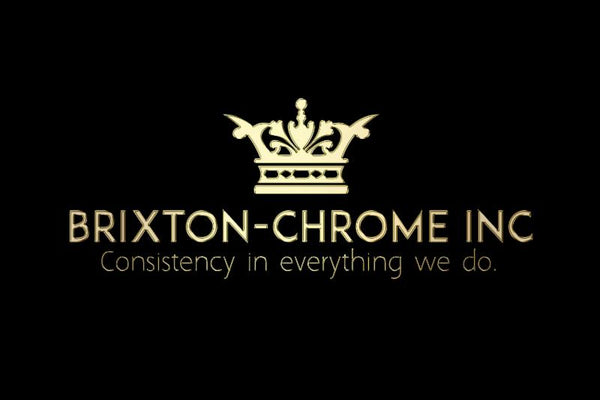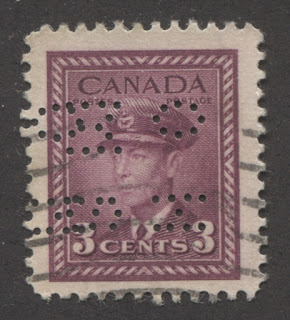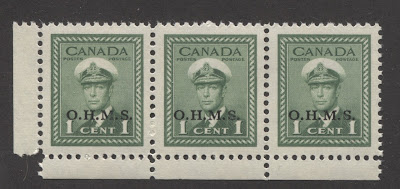OHMS Perfins and Overprints
This was the first issue to feature both OHMS perfins and overprints in the same set.
OHMS Perfins
The only perfin type in use at this point was the 4-hole type shown above. However, there were three sub-types of the 4-hole type, the second of which came into use in 1942:
- The first type, which was used until 1946, has a narrow "O", which can be difficult to identify if you are not familiar with these. However, this type can be positively identified by looking at the seventh hole from the top of the "S" and noting where it is in relation to the first and sixth holes. The first and sixth holes are aligned vertically. However, the seventh pin is not quite vertically aligned with these two pins, being just slightly off to the right of them.
- The second type, which was in use between 1942 and 1949 occurs on seven of the 10 dies used during this period. It is characterized by a wider "O", but also by the fact that the seventh hole of the "S" does line up vertically with the first and sixth holes.
- The third type is really a subset of the second type above, and was used for three of the 10 dies used from 1942-1949. It is the same as the first type, except that the "O" is wide, like the second type.
In addition to the usual 8 positions that all three of these perforated initials can be found in, the initials can also be found with various errors like double perforating, as in the example shown above. For those of you who have not read my other posts in which I talk about the perforated official stamps, the 8 different positions that I am referring to are:
- Upright, reading from left to right.
- Upright reading from right to left.
- Inverted, reading from left to right,
- Inverted, reading from right to left.
- Sideways, with the OH on the right reading upwards.
- Sideways, with the OH on the right reading downwards.
- Sideways, with the OH on the left reading upwards.
- Sideways, with the OH on the left reading downwards.
- 3c carmine red.
- 4c grain elevators.
- 13c ram tank.
- 16c airmail special delivery.
All values exist mint, and so far as I know, can be collected as plate blocks as well, though I am not sure which plates exist with these perfins. However, establishing which ones exist could be a fun and worthwhile exercise.
So to recap, with 19 basic stamps in the set, you could potentially have:
- Up to 152 stamps with the first perfin type, if all positions exist.
- Up to 120 stamps with the second perfin type, if all positions exist.
- Up to 120 stamps with the third perfin type, if all positions exist.
In terms of authenticity, most of these catalogue little more than the non-perforated stamps, so that except for the very rare positions and errors, most stamps that you see are likely to be genuine. However, care should be taken in buying the following stamps, as they list for significantly more than the non-perforated stamps:
- The $1 destroyer in used condition.
- Both airmail special delivery stamps in either mint or used condition.
- The special delivery issue, again in both mint and used condition.
OHMS Overprints
In late 1949, the Post Office Department decided to replace the method of production of the official stamps, from perforating to overprinting. An overprint forme was produced that applied the overprint "O.H.M.S." in a straight line across the 1c, 2c, 3c rose violet and 4c carmine. The spacing between the overprint between stamps in the horizontal direction was the same between all the stamps in columns 2 through 10, but was narrower between the stamps in column 1 and those in column 2. Thus one popular way to collect these, is in what is called "narrow spacing strips of three, which will show the normal spacing between the second and third stamps, and the narrower spacing between the first and second stamps. An example of a narrow spacing strip is shown below:
Note how the "S" on the left hand stamp is well to the right of the right "1", whereas on the other two stamps, it is to the left of the "1". In other words, the space between the overprints on the first two stamps is narrower than between the second and third stamps.
There also exists a "no period after s" variety that occurs on only one position, of the sheet. This variety is quite rare and desired by specialists. On this issue, it occurs on:
- The 1c green. As far as I know, it has not been plated, as yet.
- The 2c brown, from position 52 of the lower left pane of plate 4.
All of the overprinted stamps can of course be collected as plate blocks, but only from those plates that were current when these stamps were issued. Interestingly, fresh printings were made exclusively for use in the overprinting, so that there are some plates which are not reported to exist without the overprint. Specifically, plates 49 and 50 of the 4c carmine red are not reported without overprint. So if you find a plate block of either plate without the overprint, you could have a rarity on your hands.
One final caution about these overprints is that in recent years, forgers have been faking them and using laser printing to overprint inexpensive sheets of stamps with the overprint. There are several things to be on the lookout for in this regard:
1. The ink of the originals should be shiny and jet black. Dull ink is very likely to have come from a fake.
2. The left vertical bar of the "M" is much thinner than the right bar. On the forgeries the left and right bars often appear thick.
3. The action of overprinting the original stamps often left a light imprint of the overprint in the gum, so that you can just make out the overprint from the gummed side of genuine stamps. This will not be the case on the forgeries, which will be flat on the gummed side, with no sign of the overprint. However, this by itself is not a fail-safe test, as I have seen genuine stamps where no imprint of the overprint is visible in the gum. So to be certain, you really have to be familiar with the appearance of the genuine overprint:
- The entire overprint, from the left side of the "O" to the end of the right period, should be 12 mm long.
- The "O" should be thinner at the top and bottom than it is on the sides.
- The two vertical bars of the "H" should be the same thickness.
- The left vertical bar of the "M" should be noticeably thinner than the right vertical bar.
- The "S" should be noticeably thinner at the top and bottom.
- The letters should be just under 2 mm high.
Generally speaking the catalogue value of the basic 1c, 3c and 4c is low enough that fake overprints should not be too prevlalent. Most of the faking effort will have been confined to the 2c value, especially used, because mint and used list for almost the same price, as well as the narrow spacing strips and the rare plates.
First Day Covers, Postal History and Cancellations
In addition to the wide variety of first day covers that can be found for this issue, there are many ways that one can approach the collecting of the postal history:
- A wide variety of advertising covers, corner card covers and hotel covers can be collected for the printed matter and local domestic rates. Alternatively, you could focus on obtaining covers from small town post offices, that are either closed now, or those that opened or closed during the life of the issue.
- The higher values can be sought on high-value local, special delivery or registered frankings, or on bulk mailing receipts.
- You could focus on exotic foreign destination covers, including airmail covers.
- This issue covers the remainder of the Second World War, and consequently, there are a large number of censored covers that can be collected, as well as patriotic covers.
As with all the definitive issues of this period, you can build very extensive and lovely collections of CDS town cancellations. They will be tricky to get on single copies of the values below 10c. However, many of these low values were used in multiples, and thus it is possible to collect them this way. There will be a lot of post offices that opened during the life of this issue that are closed today, or that closed while this issue was current, and you could focus on collecting those. Finally, each major province had a few thousand post offices each by the 1940's, so one collecting idea would be to get as many different Alberta cancels as possible on this issue for example. That would be a fun pursuit that wouldn't cost too much money, but which over time could become quite a valuable collection.
Postal Stationery
The postal stationery continued to use the same designs as the Mufti Issue. The major difference is that the dies, starting in 1943, incorporated the date, which makes them easy to distinguish from the earlier printings. Also, the colour of the 2c, 3c and new 4c envelope was based loosely on the colour of the stamps in the issue, so that the 3c is rose violet, the 2c is brown and the 4c is carmine-red.
The same range of #8 and #10 envelopes continued to be offered as before, and the postcards bore similar inscriptions to the earlier issues.
Pre-Stamped Envelopes
The envelopes issued during this period are all printed using the offset method, rather than typography, although there are two exceptions. The date "19" and "43" appear in the lower corners instead of "19" and "38". The veins inside the leaf are weak, falling short of the outlines of the leaf. There is also a very small dot inside the "A" of "Postage".
The following #8 envelopes exist:
- 1c pale green
- 2c grey brown
- 2c olive green (I think this is probably from the 1951-52 period)
- 2c bistre
- 3c light mauve
- 3c purple (this ius typograhed)
- 4c red (this is typographed)
- 4c pale rose
- 4c orange (again, I believe this was issued in the 1951-52 period)
All the above envelopes also exist in the #10 size. There is a very rare error in which 3/4 of the design of the 3c purple, appears to be printed on top of a 4c red. This error is only known on the #8 size. The 4c orange and the 4c red #8 size exist with a constant plate flaw which resembles a hole in the king's forehead. Finally, the 3c light mauve exists watermarked "Victory Bond".
Post Bands and Wrappers
A 2c post band was issued in olive green, and this exists precancelled with three sets of horizontal bars. In addition, a wrapper was also issued in olive green, but this is not known precancelled.
Post Cards
There were a small handful of cards issued during this period:
- 2c sepia card, dated 1943 with no inscription. This is known precancelled with three sets of parallel bars.
- 2c sepia + 2c sepia reply card. There are two types. One has "Canada Post Card" in English on the message portion, while the other is bilingual.
- 2c olive green card, dated 1943 with no inscription. This is known precancelled with three sets of parallel bars.
- 2c olive-green + 2c olive-green reply card. There are two types. One has "Canada Post Card" in English on the message portion, while the other is bilingual.
- 3c mauve typographed card. This exists in three types. The first has no inscription. The second has "Canada Post Card" in the top centre, and the third has a bilingual inscription.
- 3c pale mauve offset card. This type only comes without inscription.
- 4c purple card. Again, this only exists without inscription.
Proof Material

The BNA Proofs website lists no fewer than 58 proof items for this issue. Most are very expensive, being valued at upwards of $1,000 a piece. They can be summarized as follows:
- 1 essay of the 1c green with a photographic vignette.
- 2 essays of the vignette of the 2c from a ferrotype, one in red and the other in black.
- 1 essay of the central vignette of the 1c green in black.
- 1 essay of the 10c design in black.
- 8 progressive proofs of the 1c, 2c, 13c and 20c in either the issued colours or close shades.
- 27 large die proofs on India paper in the issued colours.
- 1 small die proof on India paper of the 1c.
- 5 large trial colour proofs on India paper of the 2c, 3c, 16c and 20c.
- 12 typographed and offset proofs in issued colours of the postal stationery items
You can check them out in more detail here:
http://www.bnaproofs.com/can-warissue.html
http://www.bnaproofs.com/can-air.html
http://www.bnaproofs.com/can-airspec.html
http://www.bnaproofs.com/can-spec.html
http://www.bnaproofs.com/can-ps-g6.html
Precancels
The last aspect of this amazing issue are the precancels. This is another area that can get quite complicated, especially when you get into errors. There are many styles of precancels ranging from three sets of parallel horizontal bars, to numbers within 2 sets of bars. Each municipality had its own numeric code assigned to it, and some of the smaller towns are quite scarce. The premier reference work for these, is of course the "Walburn Specialized catalogue of Canadian Precancels". However, I will give a brief summary here of which values are known precancelled, and how many different styles are known to exist. Please bear in mind though, that any given style can exist inverted, badly slanted, doubled, etc. These are worth a considerable premium of course, over the basic Unitrade values. Also note that Unitrade generally only lists precancels in used condition, that is to say without gum. However, just as is the case with the later Elizabethan issues, it should, at least in theory, be possible to collect these in mint condition, with full gum, as well as in warning strips. A warning strip is a large block, usually either from the top of the sheet, or the sides. The selvage of these blocks would contain a warning message to the effect that the stamps were only to be used as authorized. The reason was that precancels were only sold by the P.O. to certain organizations or businesses, by the sheet, at a discount from face value. They were not available to the general public, and misuse by the public was actually illegal.
I have never actually seen any warning strip earlier than the 1953 Karsh issue, so unfortunately I cannot even describe what they would look like on this issue, if they do in fact exist.
The following values from this issue are known precancelled:
- 1c green - 30 different styles.
- 2c brown - 17 styles.
- 3c carmine red - 6 styles.
- 3c claret - 11 styles.
- 4c carmine - just 1 style, which is very surprising.
- 5c Prussian blue - 1 style.
- 1c green, perf. 8 coil - 1 style.
- 1c green, perf 9.5 coil - 1 style.
That brings me to the end of this very interesting wartime issue. It was a rather short post today, as the most detailed aspects of this issue were covered in the first two posts. However it is my hope, with these three posts, that at least some of you are inspired to consider issues like this for lifetime collections. The amazing thing about this issue is that the basic stamps are not too expensive, so that you can keep collecting and studying the material that you acquire, while you wait for the really rare proof items, coil varieties, full sheets and covers to become available. If you are thinking that there is not enough material in these early modern issues to challenge you, hopefully these last several weeks worth of posts will have laid those concerns to rest. In fact, these early modern issues starting with the Dated Die Issue in 1935 are really the only ones in which many of you have a realistic chance of being able to form truly complete "all-aspects" collections of. Even then, you will need deep pockets once you get to the proof material. But at least, the possibility exists, whereas it is not possible to form a complete "all aspects" collection of the Large Queens, or the Admirals. It is not possible, simply because a lot of the material originally printed simply does not exist anymore, in any condition. The best that collectors interested in those issues can hope to accomplish, is to form the very best collection ever formed, which will still be amazing. However, it won't be complete.
Over the next four weeks, I will complete the King George VI period with these posts:
- The Peace Issue of 1946-1951.
- The Postes-Postage issue of 1949-1952.
- The Natural Resources Definitives of 1950-1952.
- The Commemorative issues of 1947-1952.
Each of these should not require more than one post, and I have already written in detail about both the 1953 Karsh Issue and the 1954 Wilding & Industry Issues. Therefore, I will begin the Elizabethan period by looking at the commemoratives that were issued during this period, as well as some special posts about the paper used during this period as well as the perforations.



